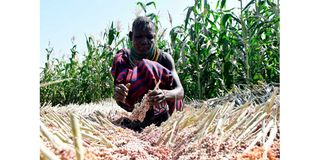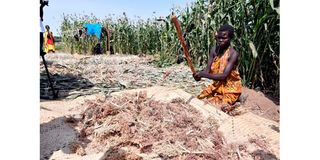Natirae farm, an oasis soothing Turkana families’ hunger

Asieng Irech sorts through sorghum she just harvested from Natirae farm on the banks of River Turkwel in Turkana County on July 19, 2022.
What you need to know:
- For the locals in this semi-arid part of Kenya who go without food for days, sorghum is gold.
- Natirae farm, named after the village is an oasis of hope for the more than 150 households here.
- Asieng Irech is fortunate to be among the direct beneficiaries of a local charity PanAfricare, that has turned this area into a productive farm.
Tuesday mid-morning, outside a tiny dome acacia hut in the northern side of Natirae farm, lies some ‘gold’. The farm is a kilometre away from Turkwel River in Turkana County.
At this hour, the weather is harsh, heating at 29°C. But Asieng Irech badly needs this heat. She has laid out sorghum on a sisal mat to dry. I find her turning the bunches she had harvested the previous day from her 0.5 acre parcel of land.
For the locals in this semi-arid part of Kenya who go without food for days, sorghum is gold.
This is her third harvest since 2020 when she first farmed. To the left side of her hut are pockets of miroo (a drought tolerant vegetable), black night shade and cowpeas.
“Once they dry, I’ll grind the sorghum into flour with grinding stones,” she says as she moves to another section of the mat to turn the sorghum.

Alice Amana sorts through sorghum harvested from the Natirae farm along the banks of River Turkwel in Turkana County.
Natirae farm, named after the village is an oasis of hope for the more than 150 households here.
In this 72-acre farm, 30 households, 18 of which are women-headed, directly grow sorghum, maize, spinach, cowpeas, black nightshade and miroo. But each household ends up feeding at least five more.
A local charity PanAfricare, turned this area into a productive farm in 2020 with clearing of the bush and constructing a one-kilometre canal that runs from Turkwel River cutting through the farm.
The soil here is sandy loam, much of which has been eroded from the surrounding arable regions of Elgeyo Marakwet and Trans Nzoia regions with the runoff that drains into the river.
PanAfricare, agriculture and natural resource management specialist Lucia Epur, says the beneficiaries were then trained on good farming practices such as conservation agriculture.
With that knowledge, they adopted minimum tillage involving clearing the bush and planting without ploughing.
This, she says, minimises soil erosion and keeps nutrients like nitrogen, phosphorus and potassium-needed for healthy growth of crops-intact. Instead of synthetic pesticides, they use biopesticides made from aloe vera and neem tree. They also dig back the crop remains, composing into manure.
Here, they practice surface irrigation. They have dug furrows to divert water into their farms from the main channel. To regulate the flow of water to avoid flooding their farms, they stack soil on the canal and unblock it at the appropriate time.

A family homestead in Loima Constituency, Turkana County. In this area, land is communally owned and it is the elders-all men- who make decisions on its use.
At the beginning, they were provided with certified seeds of the drought resistant crops which mature in three months, she says.
They are expected to create seed banks (reserved seeds from a harvest) for the subsequent planting seasons, Ms Epur says.
With the project, the organisation sought to eliminate hunger, which aligns with the global goal of ending hunger by 2030.
Ms Irech considers herself fortunate to be among the direct beneficiaries.
She cannot tell how much she harvests in each season, since she shares 90 per cent of her produce with five to six women from different households in the village.
“Here is it about sharing. Otherwise, women and children will die of hunger,” she says.
In the years prior to her first harvest in November 2020, Ms Irech says they would either sleep hungry or feed on wild fruits and dead goats, harmful food alternatives.
She has five children. Her youngest son who sits next to her on a mound of sorghum stalks where we settle for the interview, looks underweight. She says he is 10 years old, but he looks six years old.
In extreme hunger, she, her lastborn and husband would fall over, which prompted her other children to walk long distances in search of food to save them, she says.
A joint analysis by Turkana County and its children and food rights partners reveal that one in 10 women in the county are acutely malnourished. This means they are suffering from nutritional deficiency resulting from either inadequate energy or protein intake, a feature that Irech manifested.
Similarly, one in every four children in Turkana County are wasted. Based on World Health Organisation (WHO) definition, a wasted child has low weight-for-height since he or she has not had food of adequate quality and quantity.
As per the 2019 Census, there are 448,868 women in Turkana, so far the second largest county in Kenya, and among the 23 devastated with drought and hunger.
Food security
Well, for today, they have something to soothe their hunger. Ms Irech says since the sorghum is yet to dry, they will eat it raw. But when she finally grinds it into flour, they will have either porridge or ugali with the vegetables on her farm only once, in a day.
Research show sorghum is a protein-rich crop, a nutrient that WHO recommends for malnourished and wasted people.
At least for now, the project has served its purpose of boosting food security and nutrition levels of the men and women-led households here.
National Drought Management Authority (NDMA) data shows in June, 2022, seven per cent of children were moderately malnourished compared to eight per cent in May, attributing the decline to stability in the food consumption in the households, perhaps a proof of the impact of the intervention.
In this village, land is communally owned and it is the elders-all men- who make decisions on its use.
Peter Ekutan is one of the elders. He says they had to allow the project to run because drought has taught them to diversify their sources of livelihood, and women were the drivers of household food security. They agreed on the parcel and each of the 30 households was allocated a portion.

Peter Ekutan Loputei, 68, an elder from Natirae says women are the drivers of household food security in their community. He embraced the project and acknowledges that drought has taught them to diversify their sources of livelihood.
“We have come to know that there is wealth in soil. That we can feed from the crops we grow,” he says.
He explains: “In our community, women are primarily responsible for feeding the family. This land is a resource for them to do so and as the elders, we had to give way.”
Last year, he had 10 goats but eight of them died due to lack of water and pasture.
This intervention has not been all rosy.
Flash floods
Turkwel River is seasonal and its flow depends on the flash floods in the surrounding Mount Elgon and the Cherangani Hills.
The river dries up or water levels are extremely low in prolonged drought. Hence, no water drains into the canal to irrigate the farm.
As such, farming activities stop until the next season of rain. According to NDMA, the county receives an annual average of 200mm of rainfall compared to the 1,700 mm in Cherangani Hills.
It is for this reason that Ekutan has had only three harvests of sorghum since August 2020 when he first planted on his 0.5 acres, with his latest yield being six bags of 50 kilograms.
Twice, the intercropped with cowpeas but armyworms fed on nearly all the plants, leaving him in food desperation.
His recent yield would last his family of 10 a year as they have conditioned themselves to a single meal per day.
This is, however, not the case for him. Soon as he harvests, relatives and friends troop to his home for a share.
“There is no way I can send them away without sorghum. They will go die. I’d rather share to save them. Once depleted we all suffer and resort to eating wild fruits and dead goats,” he posits as he points to three women sitting nearby who have benefitted from his benevolence.
Climate change
He says he has avoided planting maize since his plantation was last year completely destroyed by armyworms.
This adaptation strategy is, however, a great step toward building food secure and resilient communities against the unpredictable extreme weather patterns.
Globally, about 2.3 billion were moderately or severely food insecure in 2021, according to food and Agriculture Organisation (FAO).
Within three years, from 2018 to 2022, food insecure population in Kenya increased from 0.7 million to the current 3.5 million based on estimates from NDMA.
As outlined in the National Climate Change Action Plan 2018-2022, the country banks on climate-smart initiatives supported by counties and national government, private sector and non-governmental organisations to achieve food security.
Not always though does investing in adaptation-oriented schemes, yield expected outcomes.
FAO notes in its 2022 report on State of Food Security and Nutrition in the World that investing in irrigation, roads, technology for storage, and low-input food preservation such as solar drying don’t necessarily guarantee success in improving dietary diversity, and affordability or access to healthy diets.
“For example, small-scale irrigation in Ethiopia and Tanzania did not improve nutrition, and although support to the fruit and vegetable value chains in seven African and Asian countries increased exports of those produce, it did not expand fruit and vegetable supply in informal markets,” it states.
It recommends infrastructure investment coupled with other measures such as extension services, support for food and agricultural marketing, and promotion of nutritious foods.
Kassim Lupao, a nutrition specialist agrees that combining irrigation with farming nutritious drought-resistant crops is key to fighting malnutrition in arid and semi-arid areas.
“Sorghum, for instance, is a highly drought-tolerant and nutritious crop that can save communities in dry areas from acute malnutrition,” he says.





